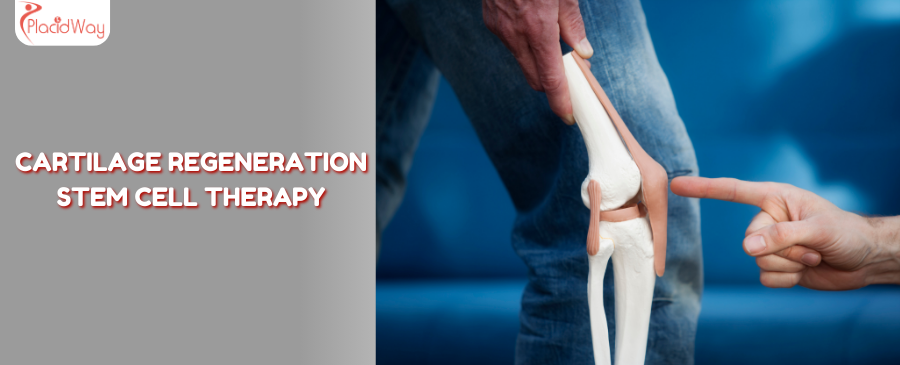
Dealing with chronic joint pain can feel like a constant battle. The stiffness, the limited mobility, and the persistent ache can significantly impact your quality of life, making even simple activities a challenge. For years, the primary solutions for severe cartilage damage were invasive surgeries like joint replacements. While effective for some, these procedures come with long recovery times and aren't always a perfect solution. But what if there was a way to help your body heal itself from within? That's where the exciting field of regenerative medicine comes in, specifically cartilage regeneration stem cell therapy. This innovative approach harnesses the power of your body's natural repair mechanisms to target joint damage at its source.
This therapy isn't about masking symptoms with medication; it's about rebuilding and restoring what's been lost. By concentrating and redirecting your own powerful stem cells to the site of injury, doctors can stimulate the growth of new, healthy cartilage tissue. This process can lead to reduced pain, improved function, and a potential delay or avoidance of major surgery. It represents a shift from simply managing a condition to actively repairing it. If you're struggling with conditions like osteoarthritis or have a sports-related cartilage injury, understanding how stem cell therapy works is the first step toward reclaiming an active, pain-free life. Let's explore the most common questions people have about this groundbreaking treatment.
What exactly is cartilage regeneration stem cell therapy?
This therapy is a form of regenerative medicine focused on healing damaged tissues naturally. The core idea is to use mesenchymal stem cells (MSCs), which are master cells capable of developing into various types of tissue, including cartilage, bone, and fat. Unlike specialized cells (like skin or muscle cells), stem cells are undifferentiated, meaning they can be guided to become the specific cells needed for repair.
When cartilage—the smooth, rubbery tissue that cushions your joints—is damaged by injury or worn down by conditions like osteoarthritis, it has a very limited ability to heal on its own due to a lack of blood supply. Stem cell therapy overcomes this limitation by delivering a high concentration of regenerative cells directly to the problem area, creating an environment that encourages healing and tissue regrowth.
How does stem cell therapy work for cartilage?
The process is multi-faceted and relies on the unique abilities of stem cells. Once injected into a joint, they initiate a powerful healing cascade. First, they release anti-inflammatory proteins that significantly reduce pain and swelling in the joint, providing immediate relief for many patients. This is a crucial first step, as chronic inflammation can prevent any meaningful healing from occurring.
Next, these cells act as signaling beacons. They release growth factors and other substances that recruit your body's own local repair cells to the site of injury. It’s like calling in a construction crew to rebuild a damaged structure. Finally, under the right conditions within the joint, the injected stem cells can differentiate, meaning they transform into new cartilage cells called chondrocytes. These new cells integrate with the existing tissue, helping to patch defects and restore a smoother joint surface.
What is the success rate of stem cell therapy for knee cartilage?
Success is often defined by two key metrics: a measurable reduction in pain and an objective improvement in joint function and mobility. For patients with mild to moderate osteoarthritis, the results are often excellent. They report being able to walk longer distances, climb stairs with less pain, and return to recreational activities they had given up.
Factors that influence the outcome include:
- Severity of Damage: Patients with earlier stages of cartilage wear tend to have better results than those with "bone-on-bone" arthritis, where there is little to no cartilage left.
- Patient's Health: Younger, healthier individuals often have more robust stem cells and a stronger healing response.
- Adherence to Post-Procedure Care: Following the doctor's rehabilitation protocol, including physical therapy, is crucial for maximizing the benefits of the treatment.
How much does stem cell therapy for cartilage regeneration cost?
The cost of cartilage regeneration can vary significantly, and it's important to understand what is included in the quoted price. Most clinics offer a package that covers the initial consultation, the cell harvesting procedure, processing the cells in the lab, and the final injection. However, things like follow-up appointments and physical therapy may be billed separately.
It's important to note that this therapy is often not covered by insurance, as it is still considered an elective or investigational treatment by many providers. Patients typically pay out-of-pocket. The cost is influenced by the source of the stem cells; bone marrow-derived cells are often more expensive to process than those from adipose (fat) tissue.
| Region | Average Cost Range (USD) | Factors Influencing Cost |
|---|---|---|
| United States | $5,000 - $10,000 | High overhead, regulatory costs, physician specialization. |
| Western Europe (e.g., Germany) | $6,000 - $12,000 | Advanced lab processing, stringent healthcare regulations. |
| Mexico / Latin America | $3,000 - $7,000 | Lower operational costs, competitive medical tourism market. |
| Asia (e.g., Thailand) | $4,000 - $8,000 | Experienced clinics catering to international patients. |
Am I a good candidate for stem cell therapy?
This treatment is not a cure-all, and a thorough evaluation by a qualified physician is necessary. Generally, the best candidates are those whose joint damage is not yet at an end-stage, "bone-on-bone" level. The therapy needs some existing cartilage to work with and a joint that is structurally sound. If the joint is severely deformed or unstable, surgery might be the only viable option.
You may be a good candidate if you:
- Experience chronic joint pain from osteoarthritis or an old injury.
- Have been told you are "not yet ready" for a joint replacement.
- Are looking for a less invasive alternative to traditional surgery.
- Have not found adequate relief from conservative treatments like physical therapy or cortisone injections.
What is the procedure like?
The procedure is typically performed on an outpatient basis. Here’s a step-by-step breakdown:
- Harvesting: The doctor first numbs an area, commonly the back of the hip (for bone marrow) or the abdomen (for fat tissue). A special needle is used to extract a sample. This part is usually quick, and while patients may feel some pressure, it is generally not described as intensely painful.
- Processing: The harvested sample is taken to an on-site lab. It is spun in a centrifuge to separate and concentrate the mesenchymal stem cells (MSCs) from other components. This process takes about 1-2 hours.
- Injection: The final, concentrated stem cell solution is prepared for injection. The doctor numbs the target joint (e.g., your knee or shoulder) and uses imaging like ultrasound to guide the needle to the exact area of cartilage damage, ensuring precise delivery.
How long does recovery take after stem cell therapy?
The recovery from stem cell therapy is significantly faster and less demanding than recovery from joint surgery. For the first few days, you may experience some soreness or swelling at the injection site, which is a normal inflammatory response as the healing process begins. Doctors advise avoiding strenuous activities and high-impact exercises for several weeks to allow the cells to engraft and begin working.
A personalized rehabilitation plan is key to a successful outcome. This usually involves gentle range-of-motion exercises at first, gradually progressing to strengthening exercises. Physical therapy helps ensure the new cartilage forms correctly and the supporting muscles are strong enough to protect the joint long-term.
Are there any side effects or risks?
Since the treatment uses your body's own biological material, the procedure is extremely safe. There is no chance of an allergic reaction or disease transmission. The primary risks are related to the injection process itself, which are the same as for any needle-based procedure:
- Infection: This is very rare when performed in a sterile clinical environment.
- Bleeding or Nerve Damage: Using imaging guidance like ultrasound dramatically reduces this already minimal risk.
- Post-injection Flare-up: Some patients experience a temporary increase in pain and swelling for a few days as the body's healing response kicks in.
How soon will I see results?
It’s important to have realistic expectations. Cartilage regeneration is a biological process that takes time. The initial reduction in inflammation can provide early relief, but the true structural repair happens over several months. You may notice small, gradual improvements week by week—less stiffness in the morning, the ability to walk a bit further without pain, or easier navigation of stairs.
The peak benefits are typically seen after the 6-month mark, as the new tissue matures and integrates into the joint. Follow-up appointments, sometimes with imaging like an MRI, can be used to track the progress of the cartilage regrowth and adjust your rehabilitation plan as needed.
Ready to Explore Your Options for Joint Pain Relief?
Don't let joint pain limit your life any longer. PlacidWay is your trusted partner in exploring cutting-edge medical treatments like stem cell therapy around the world. We connect you with world-class, accredited clinics and specialists to help you find the right solution for your needs. Discover affordable, high-quality healthcare options and take the first step towards a more active future.
Stem Cell Therapy Abroad





.png)
.png)
.png)
.png)

Share this listing